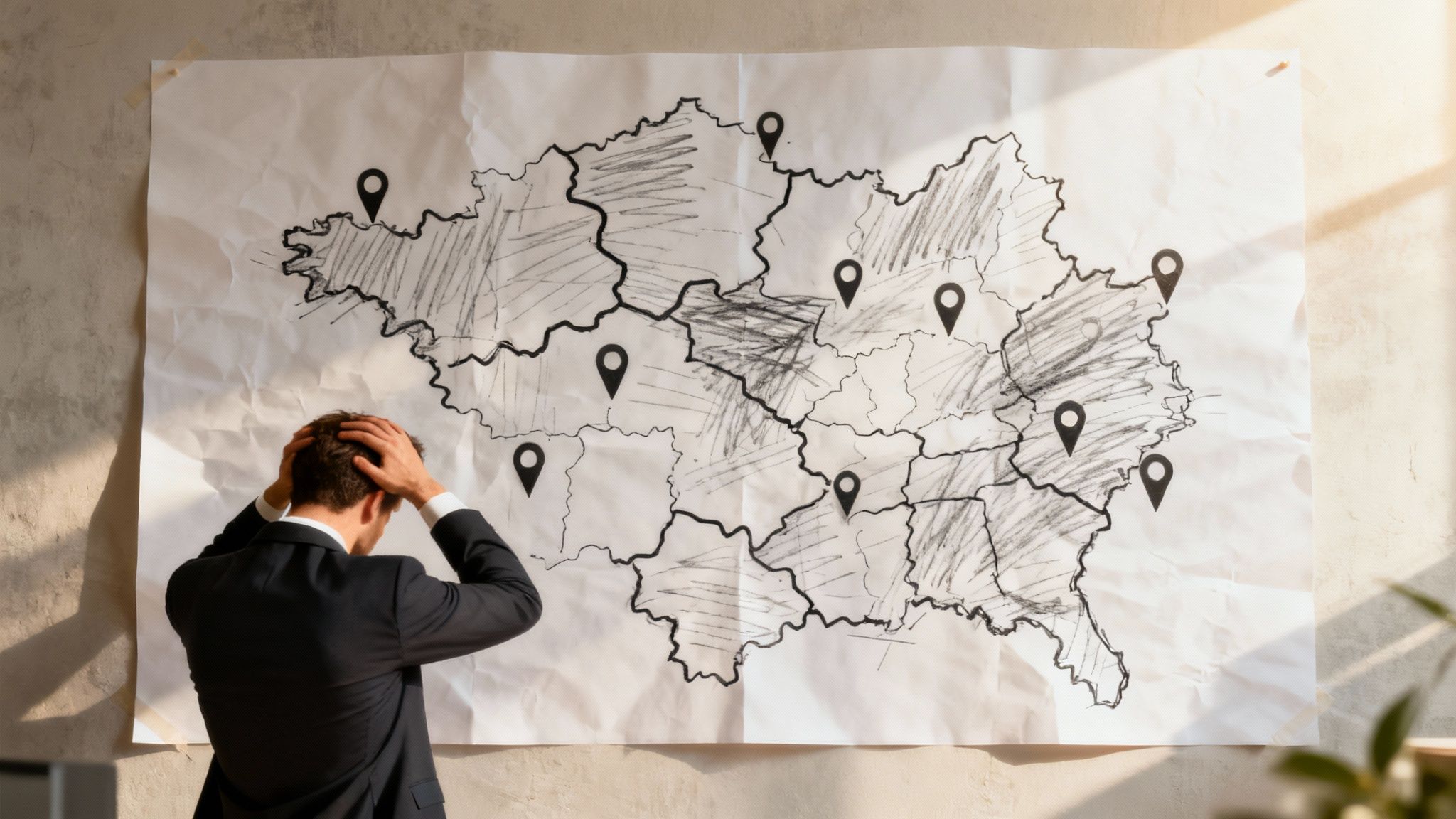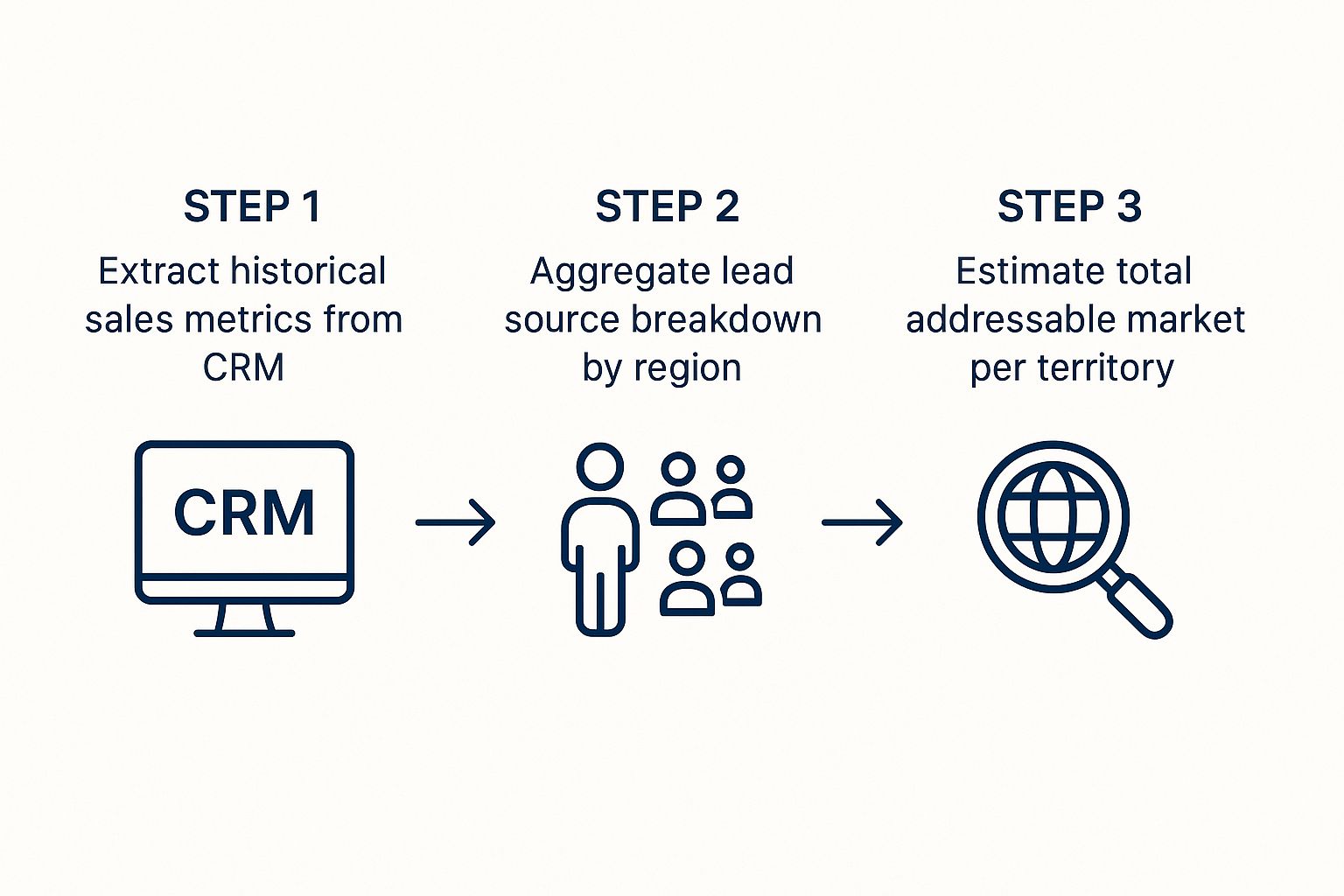A Guide to Sales Territory Management
Unlock growth with our guide to sales territory management. Learn to design, implement, and optimize territories for peak sales performance and...
A practical guide to designing a sales rep territory plan that boosts morale and revenue. Learn data-driven strategies for balanced and effective territories.
A sales rep territory is a defined group of customers or a geographic area assigned to a specific salesperson or team. But it's more than just lines on a map; it's a strategic framework for maximizing sales coverage, balancing workloads, and aiming your team’s efforts at the best market opportunities.

Let's be honest—many sales territories are based on gut feelings or old assumptions. A sales manager might draw a few lines on a map, split accounts alphabetically, and call it a day. It's simple, but this approach creates hidden problems that chip away at your revenue.
When a sales rep territory isn't designed with data, it becomes a source of frustration and missed deals. The consequences affect the entire sales floor, from individual morale to the company's bottom line.
An unbalanced territory plan is a recipe for team-wide trouble. Some reps are drowning in low-potential accounts spread across vast distances, while others get a dense, target-rich environment. This isn't just unfair; it sabotages performance.
The most common side effects include:
A poorly designed territory doesn't just limit your top performers—it puts a ceiling on what your entire team can achieve.
Moving from guesswork to a data-driven approach is critical for growth. It’s about building a system where every rep has a fair shot at hitting their target. This isn't just about redrawing boundaries; it's about changing how you view your market.
The data backs this up. One study found that companies with well-defined sales territories saw a 14% increase in sales and a 28% higher customer retention rate. You can explore more sales performance statistics to see the full impact. This shift makes your sales rep territory strategy a powerful lever for predictable revenue, not a roadblock.
A strong sales territory plan starts with the right data. Before you draw any lines on a map, you need a clear picture of your market. This means digging into the metrics that define opportunity.
Your CRM is the best place to start. It’s a goldmine of historical sales data showing where your team has succeeded. Look for patterns in closed-won deals, check the average deal size by region, and analyze sales cycle length. This grounds your strategy in reality, not assumptions.
The process involves pulling data from your CRM, understanding lead sources, and estimating your total addressable market.

This workflow shows how to turn raw data into the strategic intelligence needed for effective territory mapping.
Beyond your own sales history, you have to understand the total potential in each area. This means defining your Total Addressable Market (TAM). The goal is to figure out the full revenue opportunity available if you achieved 100% market share.
To understand your TAM, blend a few different sources:
Using external data helps you see beyond your current customers and spot untapped markets with high growth potential.
Don’t just look at where you’ve won deals—look at where you could be winning. The biggest opportunities often lie where your team hasn't focused yet.
Where are your best leads coming from? Dive into your marketing automation platform and analyze lead sources by geographic area. You might find that inbound leads from the West Coast convert at a higher rate, while the East Coast responds better to outbound prospecting.
This insight helps you align your sales reps' skills with the dynamics of each market.
Next, layer in competitive intelligence. Map out where your key competitors have a strong presence or a dense customer base. This can help you decide whether to challenge them head-on or focus on less saturated areas.
Finally, consider adding a layer of buying signals. To better find prospects who are actively looking for a solution, learn more about what is intent data and how it can supercharge your analysis. It helps you prioritize accounts that are ready to talk now.

You’ve gathered the data. Now it’s time to turn analysis into action. This is where you translate numbers into a smart territory design that gives every person on your team a real shot at winning.
The goal here is balance. Not just carving up a map, but balancing workload, potential, and opportunity.
A common mistake is drawing circles on a map based on gut feel. A better approach starts with a question: which territory model fits our sales process and customers?
Let's unpack the main ways to structure territories. You're not locked into just one. Many effective sales teams use a hybrid model, blending elements to match different market segments or sales roles.
A breakdown of the three primary models for structuring sales territories to help you choose the best fit for your team and market.
| Model Type | Best For | Key Advantage | Potential Downside |
|---|---|---|---|
| Geographic Model | Teams with significant field sales or location-dependent products. | Minimizes travel time and simplifies planning. | Can create major imbalances in sales potential (e.g., NYC vs. rural Montana). |
| Account-Based Model | Upselling/cross-selling to high-value existing customers; targeting strategic accounts. | Fosters deep customer relationships and expertise. | Can be inefficient for prospecting new business outside the named accounts. |
| Industry-Vertical Model | Companies serving multiple distinct industries with unique needs (e.g., healthcare, finance). | Reps become true subject-matter experts, which builds credibility. | Requires deep industry training and can limit cross-vertical collaboration. |
Choosing a model is the first step. But you also need a solid system for routing inbound leads. A perfectly designed territory means nothing if leads get lost. That's why building effective lead routing strategies is critical to making your design work.
The best sales rep territory design feels fair to everyone. It eliminates the "feast or famine" dynamic, where one rep has a goldmine and another has an uphill battle. True balance is the foundation of team morale and peak performance.
Once you've picked a model, the real balancing act begins. A territory that looks small on a map might be packed with high-value accounts, creating a massive workload. A huge geographic area could have only a handful of prospects.
To build territories that are fair and motivating, weigh a few key factors:
Modern tools are a game-changer here. I’ve seen companies that adopt data-driven approaches improve quota attainment by over twenty percent.
To sharpen this process, use enriched data to get a clearer picture of your accounts. Our guide on B2B data enrichment is a great place to start.

Designing territories is a data challenge; assigning them is a people challenge. After all the data analysis and map drawing, you’re left with the most crucial step: putting the right person in the right sales rep territory.
This is the moment a strategic map becomes a motivated sales force.
Get this wrong, and your hard work can unravel fast. Placing a rep in a territory that doesn’t match their skills or experience is a recipe for frustration and poor performance. The goal is to create a symbiotic relationship where both the rep and the territory thrive.
A thoughtful assignment process isn't just about filling slots on a map. It’s about leveraging the unique strengths of each person on your team.
Before making assignments, build a profile for each of your reps. Don’t just look at last quarter's numbers. Dig into the qualitative factors that drive their success. Our guide on how to manage a sales team is a great starting point for understanding individual motivations.
Think about each rep through these lenses:
The perfect assignment is a win-win. It gives the rep a territory where they can excel and provides the accounts with the exact type of salesperson they need.
How you communicate territory assignments is as important as the assignments themselves. A lack of transparency can create distrust, even if the changes are strategically sound. Be ready to explain the "why" behind every decision.
When you roll out the new territories, sit down with each rep individually. Don't use a group email. Walk them through the data you used to design their sales rep territory. Point out the opportunities and explain why you believe they are the perfect person for the job.
Frame it as a strategic move designed for their success, not just a logistical shuffle.
By showing your reps the process was data-driven, fair, and designed to play to their strengths, you build trust and excitement. This transforms a potentially disruptive change into a moment of team alignment.
Your market never sits still, and neither should your territory plan. The map you drew last year is probably already out of date. A great territory strategy is a living document that evolves with your business.
Thinking of your territory plan as static is a fast track to misalignment. Market dynamics shift, new competitors emerge, and your team changes. Staying on top of these shifts keeps your sales engine tuned for long-term growth.
This comes down to a regular review cadence. An annual deep dive is a great starting point, with lighter quarterly check-ins to spot problems early.
So, how often should you review your territories? A full realignment is a heavy lift, so a thorough review once a year is a solid baseline. This is your chance to re-evaluate everything with a full year of performance data.
But you can't wait 12 months to make adjustments. That’s where quarterly reviews come in. These are lighter check-ins focused on key metrics, allowing you to stay agile and fix minor imbalances before they become major issues.
Your territory plan is a hypothesis about your market. Regular reviews are how you test that hypothesis, learn from the results, and sharpen your approach.
During your reviews, look beyond just revenue. A healthy sales territory has several vital signs. Keep an eye on these KPIs for each territory to get the full story.
Tracking these numbers gives you the objective data you need to make smart adjustments. Checking out some RevOps best practices can give you a strong framework for monitoring these KPIs effectively.
Beyond scheduled reviews, some events should automatically trigger a fresh look at your map. Be ready to act when you see:
By staying alert to these triggers, you can adapt your sales territory strategy in real-time, keeping your team aligned with the best opportunities.
As you design your sales territories, a few questions always come up. Every sales leader hits the same roadblocks on timing, common mistakes, and picking the right tech. Getting those questions answered is the last step before moving forward with confidence.
Think of this as your quick-reference guide. We'll tackle the most common questions with straightforward, practical advice.
A full, ground-up review once a year is a solid baseline. This gives you enough data to spot trends and make strategic shifts. But the key is to stay nimble. Be ready for smaller tweaks quarterly or semi-annually as the market changes.
Beyond the annual review, certain events should be an automatic trigger to review the map:
Don't let your territory plan gather dust. Regular check-ins ensure your map reflects the real world.
Easy. The single biggest mistake is carving up territories based only on geography while ignoring workload and potential. It looks clean on a map, but it creates massive imbalances that crush morale and hamstring performance.
This is how you get "feast or famine" territories. One rep gets a massive geographic patch with a handful of real prospects, while another has a tiny city packed with high-value accounts.
Always balance geography with real-world factors like account count, market potential, and drive time. A territory might look small on a map but have 200 high-touch accounts, while a much larger one only has 20. Real balance comes from looking at the entire opportunity, not just the zip codes.
A spreadsheet might work if you have a small team. But for any team serious about growth, dedicated territory mapping software is a game-changer. Manually balancing dozens of factors across multiple reps is a recipe for costly mistakes.
Modern tools help you visualize data and automate the balancing act.
These tools don't just save time; they lead to far more accurate, data-driven decisions. They turn a messy puzzle into a clear strategic exercise.
Stop letting your sales team waste hours on manual account research. Salesmotion uses AI to monitor every signal across your target accounts and delivers actionable insights directly to your reps. See how you can increase pipeline by 40% and save each rep 8+ hours per week. Get a demo of Salesmotion today.
Unlock growth with our guide to sales territory management. Learn to design, implement, and optimize territories for peak sales performance and...
Unlock rapid growth with these 8 proven Series A startup sales strategies. A deep dive into actionable tactics from PLG to ABS for scaling your...
Explore zoominfo alternatives (including salesmotion) and compare top options, features, and pricing to pick the best fit for your sales team.